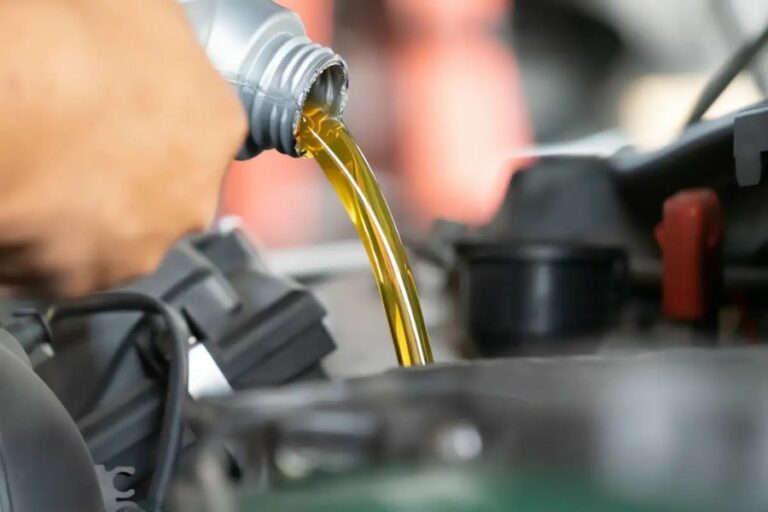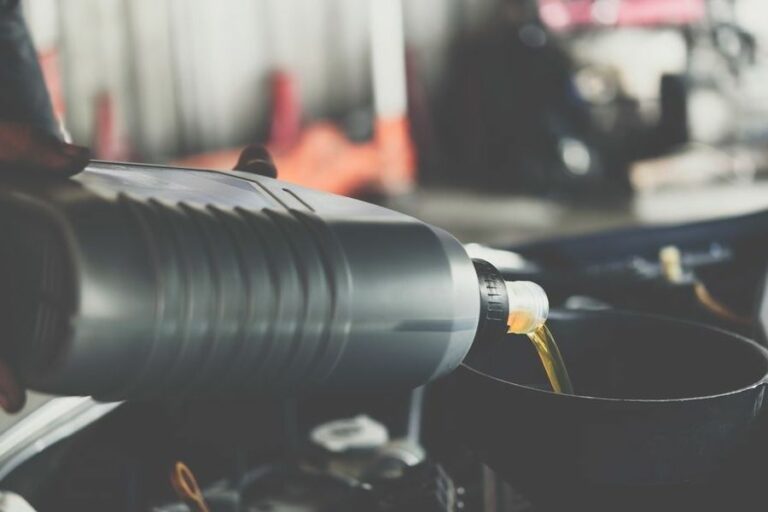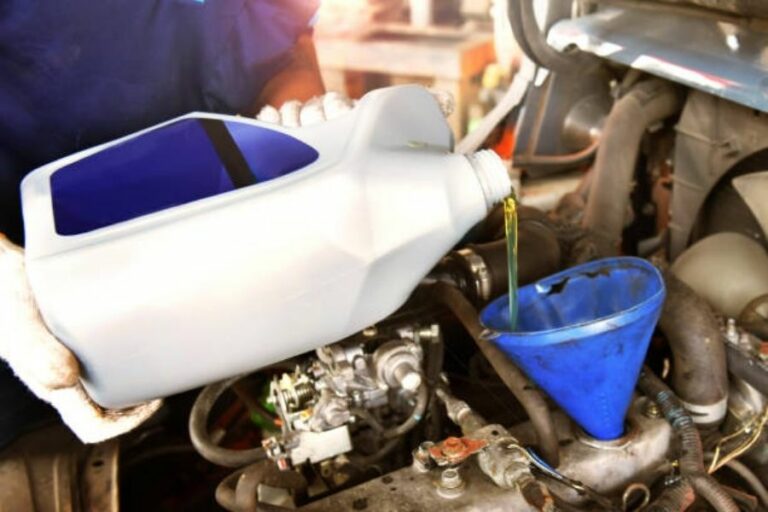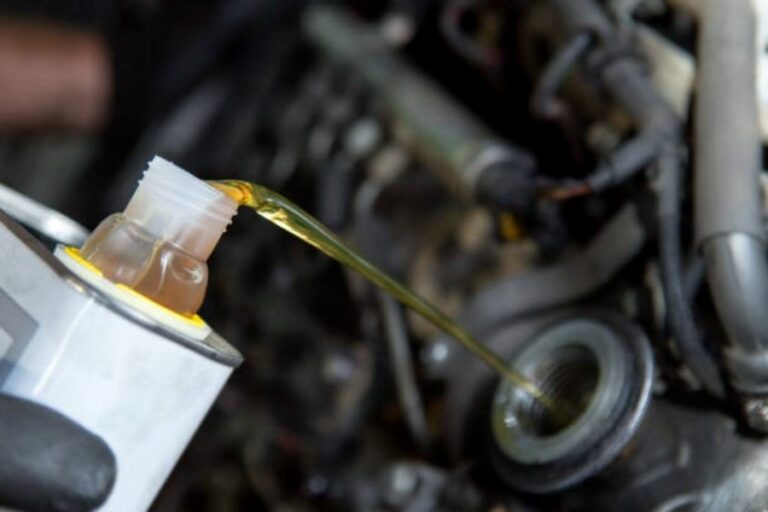Can You Use Transmission Fluid For Brake Fluid?(Avoid Risk)
It’s no surprise that when you’re pressed for time, you might wish to use something other than what’s recommended by the maker. You may have come across a forum post in which they suggested that brake fluid is replaceable with transmission fluid, and you thought it to be true.
But can you use transmission fluid for brake fluid? Simple answer: Absolutely no! Transmission fluid and brake fluid are completely distinct fluid solutions. While brake fluid remains relatively stable during heat exposure, ATF has a flash point in high temperatures. So, transmission fluid won’t last even a minute.
However, the more annoying fact is that using transmission fluid as brake fluid can even destroy your braking system.
Yes, you saw it right. Just read through our article to find some negative consequences of transmission fluid in the braking system.
What Happens If You Use Transmission Fluid As Brake Fluid?
Yes, we know your engine and transmission are both necessities to go. And your power steering assists you in guiding your vehicle where you want. However, none of that corresponds to battling the issue if you can’t stop your vehicle properly when it requires most.
So, be aware of the following consequences of adding transmission fluid instead of brake fluid:

1. Smoke in The Braking System
As a consequence of adding the wrong fluid into your braking system, smoke will accumulate. In transmission fluids, petroleum is used as the base oil, but brake fluids are non-petroleum products.
That is why transmission fluid generates excessive heat in contact with rubber components inside the baking system. The different proportions of brake fluid and transmission fluid can have a truly concerning impact on your whole braking component.
Read Also: How To Troubleshoot Brake Fluid Leaking From Rear Wheel?
2. Quick Vaporization
The vaporization of any fluid depends on its boiling point. If you see the differences between transmission fluid and brake fluid (in the later sections), you’ll see transmission fluids have a lower boiling point.
Since the boiling point is low, the transmission fluid will be vaporized more quickly than the brake fluid. And, of course, you won’t let your baking system remain empty of any fluid.
3. Blockage Inside Braking System
The seals within brakes can be damaged by heat generated from utilizing transmission fluid. When these seals are broken, the metallic parts will be exposed.
Consequently, the moisture content in transmission fluid will corrode or lead to rust buildup on metallic parts. At the same time, broken seals can obstruct the usual flow of fluid in the flow passage.
Read Also: Can You Use Marvel Mystery Oil In Transmission? (Explained)
4. Residue Buildup
The transmission fluid’s thermal expansion is higher than brake fluids. Transmission fluids often tend to compress air pockets when the temperature is high.
This will also reduce the amount of gravity within most fluids, causing them to condense and compress.
Because of this, they must be carefully cooled within a cooled basin or in some comparable environment, which is impossible for some heads-up fluid kinds.
Therefore, if a certain type of fluid is left in the storage tank for too long, it will contaminate all its components.
When petroleum products are heavier than the transmission fluid, they do not mix with them, and they cause damage to occur.
What Can You Substitute For Brake Fluid?
Unexpectedly, the brake warning light on the cruise cluster attracts your attention, an extremely underrated on-the-go warning but a very worthy component of a car. There are a thousand distinct techniques and tests that go into the creation of car parts.
So when you’re uncertain about what exactly to do, it’s frequently recommended to inquire about the help and opinions of your mechanic. Here are a few substitutes for brake fluid you can use to eliminate any sudden difficulty.
A mixture of Soap and Water,
The most readily available emergency brake fluid substitute is a mixture of conventional water and soap.
When you need an emergency brake fluid substitute, making a solution of water and soap is easy. You could hardly find any house that doesn’t have these items.
It is also the optimal means to extricate brake fluid because it will not corrode or cause rusting, provided you haven’t left it in the brake system for too long.
All kinds of soap, such as liquid or bar soap, can make an emergency brake fluid. The soap will provide the lubrication necessary, and as long as you have some water on hand, the brake fluid will work the same way.
The solution isn’t flammable but has a lower boiling point and can simmer if you apply it as brake fluid. So, take care not to apply the brakes too frequently; doing so will cause the fluid to boil and splatter.
Since your engine offers adequate stopping power without dangerous overheating, it’s better to minimize using brakes and use them only occasionally.
Read Also: Does Brake Fluid Leak When Car Is Off? Explained
Radiator Fluid
Some people claim radiator fluid to be a temporary solution. Here, temporary means strictly temporary, the lowest time you can keep the fluid inside the braking system. And you can go for this substitute when you have nothing to work around.
Radiator fluid is also known as coolant. Its main purpose is to prevent overheating engines.
As we know, brake fluid never acts as a coolant because it requires the presence of water, which can lead to the corrosion of metallic parts.
That means you must be cautious even when choosing a radiator fluid for the sole purpose of cooling the engine.
Differences Between Transmission Fluid And Brake Fluid
Brake fluid and transmission fluid are two key fluids for your automobile; they are formulated for different purposes, and you should by no means interchange these fluids.
To give you a concrete grasp of these two fluid options, we thoroughly distinguish them according to a number of grounds. Start with a quick glimpse of their major differences in the comparison table below:
| Fluid Type | Class/Brand | Viscosity | Boiling Point | Chemical Composition |
| Transmission Fluid | Valvoline Professional | 15.4 mm²/s | 428°F/220°C | Full Synthetic |
| Transmission Fluid | Mobil™ Multi-Vehicle | 5.85 mm²/s | 424°F/217°C | Full Synthetic |
| Transmission Fluid | Castrol Transmax DEX/MERC | 5.9 mm²/s | 424°F/218°C | Conventional |
| Brake Fluid | DOT 5 | 1.5 mm2/s | 500°F/260°C | Silicone |
| Brake Fluid | DOT 5.1 | 1.5 mm2/s | 500°F/260°C | Glycol Ether/Borate Ester |
| Brake Fluid | DOT 4 | 1.5 mm2/s | 446°F/230°C | Glycol Ether/Borate Ester |
| Brake Fluid | DOT 3 | 1.5 mm2/s | 401°F/205°C | Glycol Ether |
Core Function
Brake fluid is a hydraulic fluid used to apply the brakes and the clutch in a car. Brake and clutch operations are essential for the proper functioning of the automobile, and brake fluid is involved in the process.
The brake fluid helps in transferring and magnifying brake force, increasing its force, and generating pressure on the brake. Simply put, the brake fluid alters the friction to a pressure change when the brakes are applied.
Moreover, transmission fluid improves the automobile’s speed. Because it contains lubricating additives, this fluid can optimally maintain all parts of the transmission that remain under continuous friction.
Classification
The classification of brake fluids makes them unique, as each class of brake fluids bears specified properties. The specification of brake fluid falls into various classes, and these include DOT-3, DOT-4, DOT-5, and DOT- 5.1. Among these, DOT-3 and DOT-4 are mostly used in the automotive industry.
You can use automated or manual transmission fluid depending on your vehicle’s transmission technology. They can also vary depending on the chemical composition, such as fully synthetic and conventional transmission fluid.
Whichever fluid you choose, make sure that the fluid is used properly, as this will help your performance drive further. Your experience will expand significantly.
Chemical Composition
Brake fluid is composed of glycol ethers (silicone rarely) and is responsible for the lubrication and protection of your vehicle’s braking system components. The chemical composition of brake fluids is specialized to withstand high temperatures.
Transmission fluid consists of petroleum as the major component, along with other solvents and additives. Transmission fluid is both a lubricating agent and a coolant inside the transmission.
Boiling Point
The boiling point of each different class of brake fluid varies greatly. For instance, the boiling point of DOT 3 brake fluids is 401 °F (205 °C), but for DOT 4 brake fluids, it’s 446 °F (236 °C).
In the case of transmission fluids, the boiling point can vary from 356 degrees Fahrenheit (180 degrees Celsius) to over 420 degrees Fahrenheit (215 degrees Celsius) (on average). Check the table below:
Viscosity
Transmission fluids have a cloudy tending compared to brake fluids that can move in only one direction. The viscosity of brake fluids is lower than the transmission fluid, which is 1.5 mm2/s.
In contrast, all the transmission fluids have intermediate to significantly higher viscosity of 5.5 mm2/s on average. Keep in mind that the thicker the fluid, the less it will deform.
FAQs
We’ve made a lot of research into this, but perhaps you have some additional questions about the interchangeability of transmission fluid and brake fluid that may not have been addressed yet.
So, the following section is prepared for those inquiries whispering in your mind.
Why do I have to keep adding brake fluid?
The most plausible explanation here can be a brake fluid leak. The main causes of brake fluid leaks include damage to brake components and wear, erosion, and oxidation, among other things. You can detect possible leaks by checking whether any fluid drips underneath the vehicle.
How often should you fill the brake fluid?
Servicing your brakes occasionally and gauging whether your manufacturer’s guidelines are being met is the best method to ascertain when to replace the brake fluid. Check your service manual’s recommendations, and follow those.
Some manufacturers indicate replacing hydraulic fluid at least two or three times annually, while others recommend changing the fluid every 45 thousand miles.
Should I use DOT 3 or DOT 4 brake fluid?
Depreciating through absorption over time, DOT 3 brake fluid will absorb less moisture than DOT 4 brake fluid from the air. Particularly at higher temperatures, DOT 4 brake fluid retains its shape and is, therefore, safer and more reliable.
What happens if you put the power steering fluid in the brake fluid?
The seals will swiftly swell if a power steering fluid contaminates the system. As the seals begin to fill up, this will drive them to move toward, obstructing the openings in the brakes that permit the braking system to function.
Can you reuse brake fluid once opened?
Don’t reuse brake fluid already used to stop a car. Besides, don’t resume brake fluid stored without draining it first because it’s highly contaminated within a short period.
Final Words
So, what’s your thought? Can you use transmission fluid for brake fluid? Let’s reminisce about the whole fact once again. Transmission fluid is not an acceptable substitute for brake fluid.
Brake fluids are thinner, and base oils are considerably different. After reading about those consequences and distinct chemical properties, you might have already realized the fact.
Regarding a serious crisis, you can opt for the alternatives we have mentioned above. However, that should be only a temporary choice.


![Mazda 3 Transmission Fluid Type and Capacity [2003-2023]](https://carfluidpro.com/wp-content/uploads/Mazda-3-Transmission-Fluid-Type-768x512.jpg)



